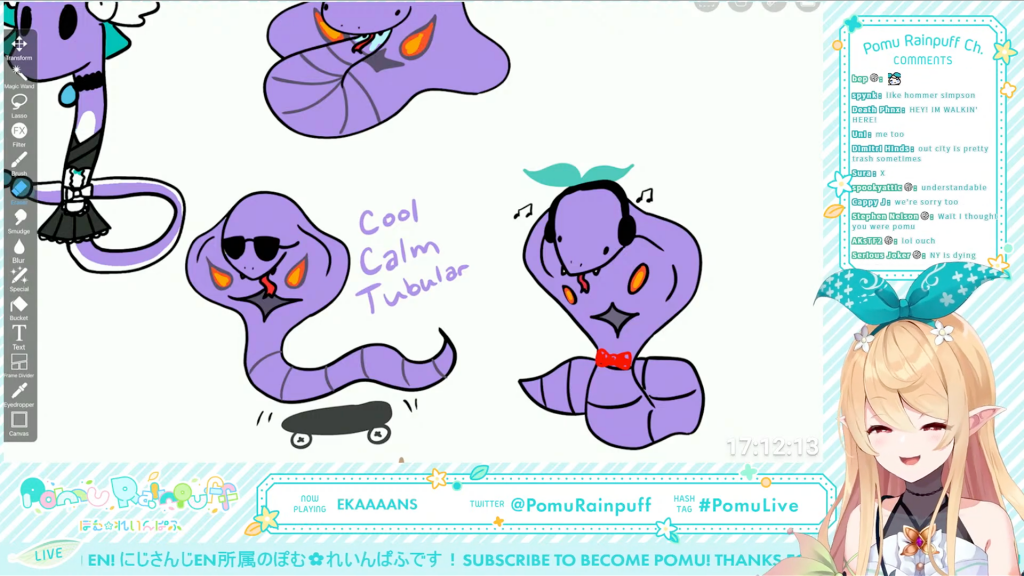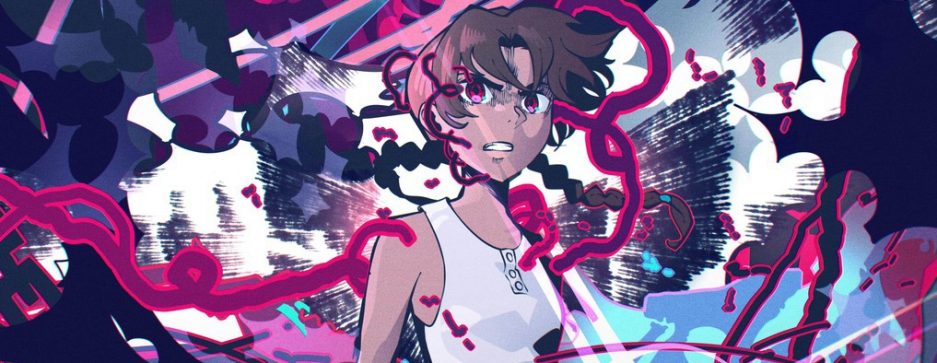
Character animation has long been considered a weakness of web animators, but there is no proof more conclusive that the world has changed than the greatest, most important milestone anime in decades:
Nijisanji.
While at first glance you might assume Nijisanji was an ordinary bishoujo zoo with too many characters and threads to be satisfying, nobody could possibly keep that opinion for long. Its popularity is just too obvious – too overwhelming. And after all, why not? Its charm is powerful. So convincing are these characters that fans treat even the less popular ones almost as if they were flesh and blood. It’s come to the point that sometimes looking at my twitter feed, I get the feeling that the sakuga community is now simply a wing of Nijisanji fandom.
The key to the show’s success lies in its unique production structure. It takes from the Disney tradition the idea of one lead animator for each character and applies it to a far different scope. Rather than the familiar breakdown of key animators, 2nd key animators, animation directors, episode directors, and inbetweeners, Nijisanji has only a “naka no hito” – the proverbial “man behind the curtain.” There are a number of ways to refer to the role in English, but the most common one is “roommate.” It’s not a term that communicates a lot about the technical nature of the role, but it does get across the sense that these animators are expected to become very close to the characters they depict. Indeed, most Nijisanji characters are damn near autobiographical – albeit there is nothing more fictional than a good autobiography. This one-to-one correspondence between animator and character belies an interesting fact: there are more women animators working on Nijisanji than any anime whose production details are known to me – more even than Kyoto Animation employs. It also means that for the purposes of this article, I’ll refer to the animator by the name of the character they animate.
What this team has been able to accomplish seems impossible. Solo KA episodes aren’t just common, they’re normal. How? How can that sentence possibly be true? I’m the one writing the article, and even I don’t firmly grasp it.
What’s more, as you can guess from the credits, this animation is all straight-ahead on the 1s: that is, the animator creates a new drawing for every frame of video without delegating any work to inbetweeners. In any other circumstance, this would be an unspeakable amount of work. As the anime pipeline fragments into smaller and smaller pieces, chasing itself into perdition to meet absurd schedules with untrained staff, it’s refreshing to see such radical autonomy. It used to be that one of the greatest contributions of anime to the arts was that it provided a structure where individual animators could make their mark. In a sense, Nijisanji is the culmination of that achievement – a landmark in the tradition of Macross: Do You Remember Love and Akira and That One Episode of Fate/Apocrypha Everyone Watched Because It Was So Lit Even Though Nobody Gives a Shit About Fate/Apocrypha.
All this is made possible by a new digital toolchain. A proprietary program which uses Live2D at its core is used for animation, while an open-source program called OBS is used for compositing. The proprietary software lets animators quickly create genga based on reference footage. Nijisanji animators generally use themselves for the footage, which, since they mostly are their characters, works quite well. This may be more important than it seems at face value. We’re still unsure exactly how Live2D works, but the best guess is that it’s some sort of rotoscoping technology. “Rotoscoping” is a dirty word – unfairly! It can be quite effective when used properly, and using it properly is a skill in itself. The fact that the 2nd ending to the first season of Kaguya-sama wa Kokurasetai animated by Naoya Nakayama is held up as a classic while poor Yuki Komatsu’s roto’d cut in The Idolm@ster Movie was widely seen as weird and awkward obviously does not mean that Komatsu – elusive legend that he is – is a lesser animator than Nakayama. The animators of Nijisanji use it well: their characters are often animated with rare specificity.
Few more than Pomu Rainpuff.
Pomu Rainpuff first appeared in Lazulight – season one of Nijisanji EN. There are rumors that she worked on previous productions under a pseudonym, and the polish of her work lends credence to this notion, but we won’t be chasing ghosts here. Ever since then, her contributions to the show have been one of its highlights.
She has a remarkable way of communicating big emotions with subtle movements. Take as example this cut from the famous PomuBreak episode:
Here, we see Pomu’s reaction to beatMARIO’s sudden appearance. As Pomu explains, beatMARIO is an elder statesman of the Touhou doujin music scene alongside figures like Masayoshi Minoshima: among the first in doujin music to make the transition from the bemaniscene and arrangements of early 2000s VN soundtracks to Touhou, and among the vanishingly few from that era who are still active. For him to show up completely unannounced and immediately start singing HELP ME, ERINNNNNN!! as she’s explaining this surprised me, to say the least. How surprising was it to her?
Watch how at first her mouth opens wide, and her eyes dart diagonally downward for a brief moment as she checks discord, as at the same time her pupils subtly contract. After the initial realization hits her, she glances slightly but sharply to her right at her friends, and afterward her mouth grows steadily more agape as her eyes dart and shake. These are all small movements, but the shock is very clearly communicated – perhaps with a little aid from the Kuleshov effect.
Truly, this is Pomu Sakuga.
This isn’t the only type of animation she excels at. Perhaps the most famous contribution of Pomu is her signature quirk: the Pomu Hand Trick.
First seen in the classic Wixoss crossover episode, the Pomu Hand Trick is, like most good animation, difficult to describe in words, except that it’s a sinusoidal motion that flows down the length of one hand into the other, and it’s tremendously charismatic. Like the Ebata Walk, there’s no particular storytelling or characterization point to this affectation, aside from the fact that Pomu is the sort of person who would learn this gesture. It’s just pure aesthetic – pure charisma.
As you can also see from that cut, her wonderful exaggerated mannerisms aren’t limited to the Hand Trick.
You can see here that there’s a Pomu Wiggle as well. The leg swing is excellent, with her hands behind her back. She claims she – meaning presumably her animator – doesn’t move like this naturally, but Pomu does! To her, these little quirks it feels as natural and fitting as Milt Kahl’s back-and-forth smug swagger looks on Shere Khan.
How is Pomu able to achieve all this? It’s not all down to the pipeline. There are unconfirmed reports that Pomu may have up to six hands. If true, this gives her a tremendous advantage, as she can animate nonstop while eating and still have hands free to hold penlights. Modern science is only beginning to understand the true power of penlights, but it is estimated that an average animator could become up to 765% more powerful if they were similarly able. In fact, it’s rumored that aniP Shouta Umehara is as capable of managing such amazing collections of talent in part because he cheers the animators on himself with wotagei and mixing. This information comes largely from a report drafted by the Japanese Ministry of Economy, Trade, and Industry (METI), which takes a prospective, practical look at penlights over the next five years and outlines best practices for studios looking to utilize them. It’s a fascinating read – it even includes recommendations for which mixes suit what type of animation.
Speculation aside, it’s clear that even without her powers as a forest fairy, Pomu would be a formidable and attractive animator. Watching her rapid development over the past year has been a tremendous pleasure in an anime industry which has become increasingly bitter. It’s no wonder that sakuga fans have embraced such an unusual production. I expect to see more animators on more projects start to use this new digital toolchain. In fact, it’s already begun. Freelance animator Franziska van Wulfen, known Pomu admirer, is now exploring the techniques for herself – quite successfully! This is how artistic movements begin. The Pomu school is rising. One day, in the annals of anime history, the names will be recorded:
Yasuji Mori
Hayao Miyazaki
Yoshinori Kanada
Takashi Nakamura
Yutaka Nakamura
Pomu Rainpuff
(okay but seriously there’s no April Fools joke, Pomu is gr8 and getting the most out of a Live2D model is a legitimate skill)
